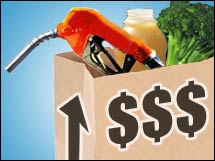|
Inflation's fear factor
Even some who believe the Fed will need to keep raising rates say price pressures won't derail the world's largest economy.
NEW YORK (CNNMoney.com) - The roar of inflation has scared Wall Street in recent days, but to some economists the sound is more like that of a house cat than that of a lion. And while the sound might get a bit louder in coming months, even some inflation hawks don't believe that inflation will get bad enough to derail the expansion in the world's largest economy, now in its fifth year.
"I don't think you have to call Volcker or Greenspan for that matter," said Rich Yamarone, director of economic research at Argus Research, referring to the last two Fed chairmen who each battled much stronger inflationary pressures than we have now. Of course, Wednesday's Consumer Price Index report stirred investor fears that in order to contain inflation, the Fed will have to hike rates much higher than many on Wall Street had hoped. Some investors had been counting on the Fed to stop once the central bank raised its short-term rate target to 5 percent, as it did last week. But now, economists say, higher short-term rates could very well be in the works. With new Fed Chairman Ben Bernanke leading the central bank, policy-makers might decide they have to establish their inflation fighting credentials at all costs, even if it means raising rates higher than might be justified by relatively modest inflationary pressures. "I'm afraid now there's a better than 50-50 chance the Fed will go to 5.25 percent in June," said Bernard Baumohl, executive director of the Economic Outlook Group, and one of those who believes the risk of inflation is modest. "The last thing it can do is being perceived as behind the curve." Baumohl is one of those who thinks that the economy will cool considerably in the second half of this year, perhaps as low as a 2 to 3 percent annual growth rate from first-quarter growth now expected to be come in above 5 percent, and growth of 4.2 percent in 2004 and 3.5 percent in 2005. And he said that slower growth should be enough to help keep prices in check. While Baumohl still thinks the Fed could stop when its rate target hits 5.25 percent, other economists such as Yamarone see a strong chance of a 5.5 percent fed funds rate later this year. The Fed raises the rate, which banks charge each other on overnight loans, when it wants to cool the economy and cuts it to spur growth. Investors fear higher rates since they slow growth, thus hurting corporate earnings. Yamarone said he could see the fed funds rate as high as 6 percent by the end of 2006. But even Yamarone sees the core CPI, which excludes often volatile food and energy prices, rising to about a 2.5 percent annual rate and probably not above 2.75 percent. And he thinks that short of another gasoline spike such of the one seen after Hurricane Katrina last year, the overall CPI should top out near a 4 percent year-over-year gain. "It's not something we like but it's not enough to upend the economy," he said. Part of the reason he thinks the economy can keep growing is that a lot of the price increases that consumers have seen are only now showing up in the government numbers. "This may be news to the Wall Street but it's not news to Main Street," he said. The alarm bell in the Wednesday inflation report was core CPI hitting a 2.3 percent 12-month gain in April, the highest since March 2005 and well above the Fed target of 1.5 to 2 percent for that reading. But a 2.5 percent annual rate of increase for "core" inflation was common during the boom of the late 1990's and into 2001, when the economy was already showing signs of a slowdown. It's a far cry from the double-digit increases seen in the late 1970s or early '80s when Volcker had to shoot the fed funds up to 19.1 percent to choke off price pressures. Stuart Hoffman, chief economist for PNC Financial Services Group, also believes that the Fed could go as high as 5.5 percent, but he doesn't think it'll be forced to take rates to even 6 percent because he believes there's enough forces at play in the economy to keep inflation under control. "I had been thinking 5 percent could be a good resting point, but it could be short of what they need to do," he said. "But 6 percent would be classic Fed overkill. There's no question you've got a buildup of inflationary pressures. But it's not like they're unchecked by anti-inflation forces such as global competition, productivity gains and the lagging effect of what the Fed has already done." ------------------------------------ For a look at the latest CPI report, click here.
For a special report, Eyes on the Fed, click here. |
|


